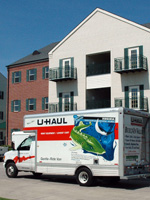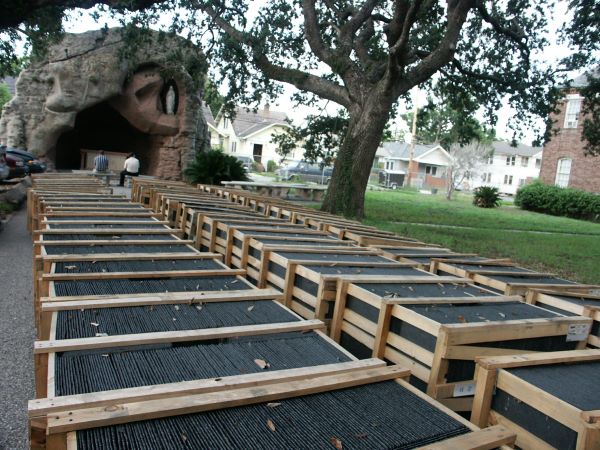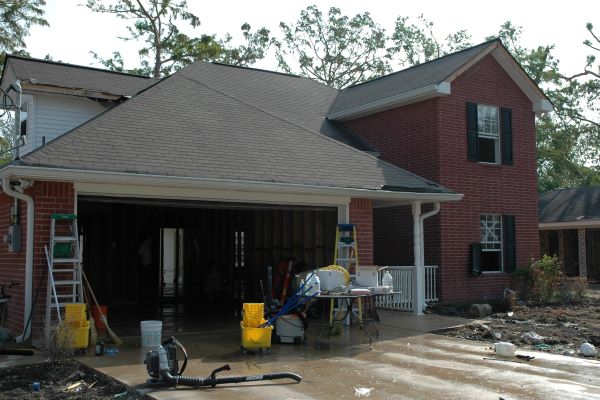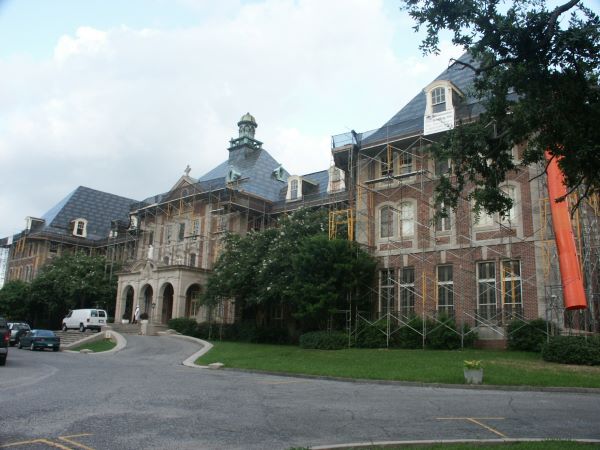 |
| Students began returning to New Orleans Baptist Seminary residence halls in June this year. |
On August 29, 2005, Hurricane Katrina struck the U.S. Gulf Coast. The next day, after it seemed the worst had passed, the levee system in New Orleans began to fail, eventually flooding 80 percent of the city. New Orleans is home to two seminaries, and both schools were evacuated as flood waters rose, leaving their buildings and property to the destructive power of the water.
After students and faculty evacuated New Orleans Baptist Theological Seminary, the Southern Baptist school's administration set up camp in Atlanta, Georgia, and began reclaiming the semester by moving some classes to their numerous extension sites and making others available online. Notre Dame Seminary, which is owned and operated by the Catholic Archdiocese of New Orleans, stayed closer to home, moving operations 40 miles north to St. Joseph Abbey and Seminary College in St. Benedict, Louisiana. Both schools were able to finish out fall classes and return to their campuses in some capacity for the Spring 2006 semester. Now, a year after the storm, both schools are fully functioning and things are getting back to normal.
New Orleans Baptist Theological Seminary
At New Orleans Baptist Theological Seminary, classes started as usual this fall. The numbers of students returning to the campus was encouraging for seminary president Charles S. Kelley Jr. "Enrollment is stronger than we thought it would be," said Dr.Kelley, "and our new student enrollment is going to be very close to last year's new student enrollment."
 |
| Crates of slate roofing tiles are lined up in front of the Lourdes grotto at Notre Dame Seminary in New Orleans. (Brandon Briscoe) |
According to the school's provost, Steve Lemke, "we already know that our total will be at least 1,000-1,200 students on the New Orleans campus and another 1,000-1,200 students at our extension centers throughout the Southeast. "These numbers are a few hundred students shy of enrollments in recent years, but they are higher than anticipated, considering how devastated the campus was by last year's flooding.
The biggest challenge since the storm has been getting the campus rebuilt. Both students and faculty live on campus, so securing housing was important. Most of the rebuilding is complete -- the last big project being the steeple on the school's chapel. "You couldn't tell it from looking at it, but the steel was structurally damaged in the storm," said Dr. Kelley. "So we are having a new steeple made and it will be back on top, probably about December."
Trustee chairman L. Ray Moncrief is proud of the progress made so far, calling the campus an oasis in the midst of the surrounding devastation. "When you look at what happened a year ago -- just the sheer process of working with insurance adjusters is incomprehensible," said Moncrief, "One would have to say that our administrative team at NOBTS did nothing short of an incredible job negotiating with insurance adjusters to maximize the insurance settlement to rebuild that campus."
As the school handled the rebuilding of different facilities on campus, decisions had to be made daily -- decisions that could not wait for an annual meeting. Accordingly, Moncrief said the board has been actively involved in decision-making all year long.
 |
| An extensive mold abatement process was completed on each faculty house at New Orleans Baptist Theological Seminary. (NOBTS) |
Dr.Kelley believes New Orleans Baptist Theological Seminary has a unique opportunity. Not only will the seminary have a chance to play a role in the overall rebuilding of New Orleans, but their location and experience also offers students a chance to learn about disaster relief and ministering to people in crisis. "We have an opportunity to prepare a whole generation of students to understand disaster experience, to prepare them for how to help during times of disaster," said Dr.Kelley. "Normal is established and we're going to be able to have a seminary. Now we get the opportunity of creating the future."
Notre Dame Seminary
Notre Dame Seminary is also back on campus. One hundred students returned in January 2006 (down from 110 who began the fall semester before the storm), and 102 students have enrolled for Fall 2006.
Construction still continues on campus. "We're in the midst of replacing the roof on our two main buildings," said Father Patrick Williams, the school's rector-president. "We still have some flooded areas -- close to half we've been able to restore. We have renovated our library completely and basically taken all of our library holdings off of the first floor so that if we ever flood again, they will be well out of harm's way."
 |
| Scaffolding surrounds the buildings at Notre Dame Seminary as workers prepare to fix the damaged roof. (BRANDON BRISCOE) |
Over the summer, several groups have lent a hand. "We had a group from a parish in western Louisiana who came under the direction of one of our alumni, a priest of that area," said Father Williams. "He brought a group from a parish that spent a week here doing a lot of work that we weren't able to get contractors to do -- a lot of little things that piled up as we were trying to address the bigger things."
The board has been very encouraging throughout the past year, helping maintain enrollment." Our board has a number of bishops whose students are here, and so sending their students back to us, and entrusting us with their students,was a big support for us," said Father Williams.
The board also played a role in making decisions about the finances needed for the reconstruction. "The finance committee of the board has helped us keep a handle on that whole situation. Those members of the board have been very helpful in providing guidance and advice on how to maximize the monies that we are receiving and how to best use them to maintain good stewardship," said Father Williams.
Returning to their campus in New Orleans has provided students with opportunities to minister to the community. "Those students who were in this local area were very involved in ministering to people affected by the storm one way or another," said Father Williams. "We've had students going out in groups themselves, helping to repair houses and gut homes."
Matt Forster is a freelance writer who lives in Goodrich, Michigan.